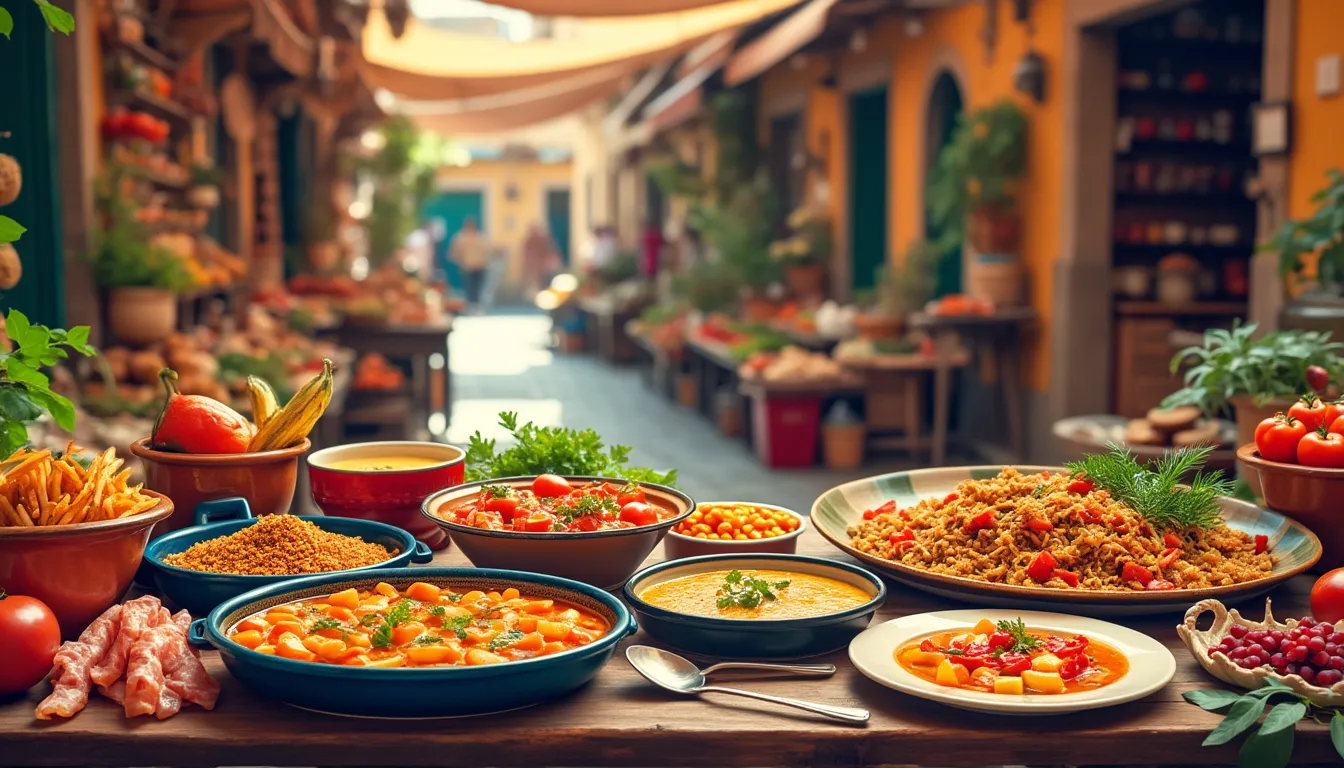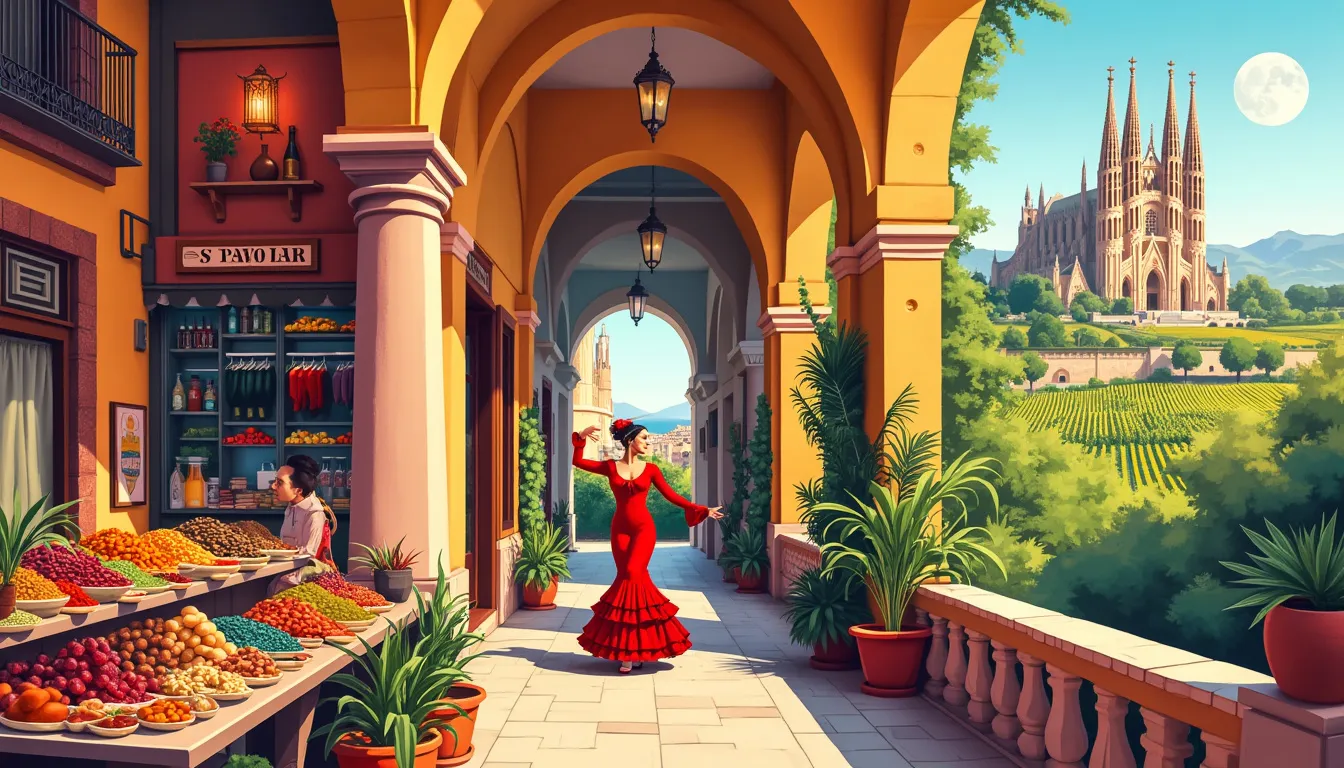Embark on an enticing journey through Spain, a nation renowned for its mesmerizing blend of culture, cuisine, and history that captivates travelers from around the globe. This vibrant country, with its diverse cultural landscapes, showcases a rich tapestry of traditions, art, and festivals deeply rooted in the distinct influences from regions such as Catalonia, Andalusia, and the Basque Country. Spain offers a cultural odyssey like no other, beckoning history aficionados to marvel at architectural wonders like the Sagrada Familia in Barcelona, the Alhambra in Granada, and the illustrious Prado Museum in Madrid. These iconic landmarks, steeped in history and artistry, make Spain an indispensable destination for those eager to explore its cultural magnificence.
The allure of Spain extends beyond its historic monuments and into its culinary prowess, offering a tantalizing gourmet journey that reflects its vibrant heritage. With an array of flavors and culinary traditions, Spanish cuisine is defined by regional specialties such as paella from Valencia, the diverse offerings of tapas, and the exquisite jamón ibérico. Each dish is a testament to Spain’s rich gastronomic culture and invites food enthusiasts to savor the authentic tastes of the country. Accompanying Spain’s culinary adventure is its celebrated wine scene. The country’s prestigious vineyards and renowned wine regions, including Rioja and Ribera del Duero, play a vital role in enhancing its gastronomic appeal. Wine lovers will find joy in exploring the intricate flavors and heritage intertwined with Spain’s dining experiences. As you delve into the essence of Spain, prepare to be enchanted by a diverse yet harmonious blend of culture, cuisine, and history, promising an unforgettable experience for every traveler who sets foot in this remarkable land.
Discovering the Rich Cultural Heritage of Spain
Spain is a country rich in cultural diversity, evident in its varied traditions, arts, and festivals. Each region of Spain offers a unique perspective, contributing to the nation’s vibrant cultural landscape. From Catalonia’s distinct identity with its own language and customs to Andalusia’s Moorish influences, Spain is a mosaic of cultures, each with its own story and traditions. The Basque Country, known for its autonomous spirit, also adds to the nation’s cultural wealth with its distinctive language and festivities.
The vibrant cultural scene in Spain is a testament to its historical tapestry, woven together by the diverse groups that have called this land home. The influence of the Romans, Moors, and the Catholic Monarchs has blended over centuries, leaving behind a rich cultural fabric that continues to thrive in the modern era. This blend of historical influences can be seen in traditional festivals, folk music, and dance, ensuring that Spain remains an exciting destination for those keen to explore world cultures.
Among Spain’s numerous cultural offerings, the festivals stand out as a lively celebration of its historical and religious past. Events such as La Tomatina in Buñol, Semana Santa (Holy Week) in Seville, and San Fermín in Pamplona offer visitors a chance to experience local culture in its most exuberant form. These festivals, often rooted in historical or religious significance, provide insight into the values and traditions that have shaped Spanish communities across the centuries.
When experiencing Spain’s cultural icons, architecture stands as a testament to the nation’s historical depth and artistic endeavor. Antoni Gaudí’s Sagrada Familia in Barcelona is not just a basilica but a towering symbol of modernist architecture, blending intricate detail with spiritual iconography. It draws millions of visitors each year, offering a glimpse into Gaudi’s visionary mind and the cultural heart of Catalonia.
In the south, the Alhambra in Granada provides a portal to Spain’s Moorish past. This stunning palace and fortress complex, with its intricate Islamic art and lush gardens, represents the height of Muslim art in Europe. Visitors can wander through the elaborately decorated rooms and sprawling courtyards, immersing themselves in the splendor and sophistication of a bygone era.
The Prado Museum in Madrid is an unmissable cultural destination for art lovers and history buffs alike. Housing thousands of works by Spanish masters such as Velázquez, Goya, and El Greco, the Prado showcases the breadth of Spain’s contribution to the art world. Its collection traces the evolution of European art, offering visitors an unparalleled opportunity to explore the creative expressions that have defined Spanish culture.
Moreover, the diverse influences that have shaped Spain are represented across the country in less monumental, yet equally significant forms. In small towns and cities, age-old traditions are preserved through local crafts, music, and dance. Flamenco, an art form with roots in Andalusia, captivates audiences with its passionate rhythms and vibrant performances, while traditional Basque music compositions provide a captivating contrast with their soulful melodies and complex instrumentation.
Faith, too, plays a significant role in Spain’s cultural heritage, with the Camino de Santiago serving as an enduring symbol of spiritual and cultural pilgrimage. This ancient network of routes draws people from all over the world to partake in a journey of spiritual reflection and cultural discovery, weaving their way through the picturesque landscapes and historical landmarks of northern Spain.
The overall cultural experience in Spain is enriched further by its dedication to preserving its history while embracing the future. Cities like Bilbao have undergone significant transformation with contemporary structures such as the Guggenheim Museum, an architectural masterpiece that signifies the city’s dynamic fusion of tradition and innovation. Such developments highlight Spain’s ability to innovate while honoring its past, providing a rich and layered cultural experience.
For the culturally curious, Spain offers an array of experiences, from visiting historical sites and partaking in traditional festivals, to discovering the compelling stories etched into its landscapes and communities. Whether wandering through the sunlit streets of Seville or exploring the rugged shores of the Basque Country, Spain invites you to uncover its wealth of cultural treasures.

Savoring Spain: A Culinary Adventure Through Authentic Cuisine
An Overview of Spanish Cuisine
Spain is a country renowned for its vibrant culinary scene, offering a wide array of flavors that reflect its rich history, diverse landscapes, and regional traditions. Its cuisine is a delicious mosaic, crafted by centuries of global influences, from the Roman and Moorish legacies to New World introductions. When one embarks on a culinary journey through Spain, it becomes evident that each dish tells a story deeply embedded in culture and tradition.
One of the most iconic dishes to emerge from the Iberian Peninsula is paella, originating from the east coast city of Valencia. This stunningly colorful rice dish is traditionally cooked in a wide, shallow pan and combines a variety of ingredients such as saffron, chicken, rabbit, snails, and a selection of vegetables. Seafood paella has also gained global recognition, highlighting the rich marine resources of Spanish coastal regions.
A trip through Spain’s culinary landscape would be incomplete without experiencing tapas. This beloved tradition of small, shareable dishes represents the essence of Spanish sociability and culinary creativity. From Andalusia to Asturias, each region offers a unique take on tapas, with selections ranging from the simple yet delightful patatas bravas to paté de marisco, offering a taste of the sea.
The Spanish obsession with ham reaches its pinnacle with jamón ibérico, a delicacy crafted from the native Iberian pigs. This cured masterpiece is celebrated for its rich, nutty flavor and is a symbol of Spain’s artisanal food heritage. The quality of jamón is often determined by the way the pigs are raised, with the finest examples coming from those fed on acorns in the oak woods of Extremadura and Andalucía.
In Catalonia, escudella i carn d’olla represents a heartfelt embodiment of Spanish comfort food. This hearty stew delivers a comforting array of meats and vegetables, typically served in two courses, beginning with a brothy soup followed by the hearty meat and vegetable components. Each region of Spain puts its spin on traditional stews, demonstrating the country’s culinary diversity.
The distinct seasons and landscapes of Spain also play a crucial role in its gastronomy. For instance, the Basque Country is a haven for seafood lovers, with its traditional bacalao al pil-pil—a savory cod dish that exemplifies Basque culinary skills. In contrast, Galicia’s green pastures and rugged coastlines deliver unique dishes like pulpo a la gallega, which highlights tender octopus seasoned with olive oil and paprika.
Unveiling the Spanish Wine Scene
Beyond food, Spain’s wine culture is an integral component of its culinary identity, with its vineyards being among the oldest in the world. Spain ranks as one of the world’s top wine producers, with more than 2.4 million acres dedicated to vine cultivation. This vast viticultural landscape showcases a remarkable variety of grapes, wines, and styles that appeal to connoisseurs and casual drinkers alike.
The renowned Rioja region, situated in Northern Spain, stands out as one of the country’s most esteemed wine territories. Known for its complex reds crafted primarily from the Tempranillo grape, Rioja wines are celebrated for their balance of fruit, weight, and nuanced aging processes in oak barrels that lend them a unique character. These wines are perfect companions to Spain’s meaty cuisine, such as lamb or suckling pig.
In a similar vein, the Ribera del Duero wine region, with its longstanding winemaking tradition, offers a sophisticated range of red wines that rival some of the best in the world. Here, the climatic extremes of hot, dry summers, and cold, harsh winters yield robust wines characterized by deep color, body, and intense flavor, usually accompanied by subtle hints of blackberries and leather.
Meanwhile, the region of Jerez, famous for its production of sherries, showcases an array of fortified wines with different styles and profiles ranging from dry Fino to sweet Pedro Ximénez. These versatile wines can start a meal, end it, or accompany dessert, reflecting the adaptability and scope of Spanish vino.
The Catalan vintners produce another noteworthy gem—Cava, Spain’s answer to sparkling wine known for its refreshing effervescence. Catalonia, especially the Penedès region, offers a variety of Cavas that range in dryness and are enjoyed both as an aperitif and alongside meals, embodying the celebratory spirit of Spanish dining.
Wine is not just a complement to Spanish food—it is part of the meal’s DNA. Whether dining at a rustic bodega or a modern tapas bar, the presence of carefully selected wines completes the Spanish dining experience, embodying the harmony between food and drink that defines the country’s gastronomic heritage.
Embarking on a culinary adventure in Spain is not merely about eating and drinking; it is an immersive journey that pays homage to the country’s unique synthesis of flavors, informed by its terrain, history, and cultural exchanges. It is a celebration of life and an unending invitation to explore the multitude of tastes that Spain has to offer.
Spain presents a compelling fusion of cultural richness, tantalizing culinary experiences, and profound historical depth that promises an unforgettable journey for any traveler. Delving into the vibrant cultural heritage, Spain’s diverse regions like Catalonia, Andalusia, and the Basque Country offer a wealth of traditions, artistry, and festivities. Each area contributes its distinct flair to the nation’s cultural mosaic, captivating visitors with its dynamic influences and iconic landmarks. Architectural wonders like the Sagrada Familia, the majestic Alhambra, and the renowned Prado Museum stand as testaments to Spain’s historical grandeur and artistic legacy, offering enriching experiences for history buffs and architecture enthusiasts.
Transitioning from culture to cuisine, Spain’s gastronomic scene is a feast for the senses. The country’s culinary offerings, from the iconic paella and delectable tapas to the exquisite jamón ibérico, reflect a rich tapestry of flavors steeped in tradition and pride. Each dish tells a story, inviting guests to explore the passions of a nation devoted to its culinary arts. Complementing these flavors is Spain’s illustrious wine scene, where the renowned vineyards of Rioja and Ribera del Duero produce wines that perfectly pair with traditional dishes, enhancing the vibrant dining experience integral to Spanish life.
In exploring Spain, one uncovers a nation defined by its deep-rooted traditions, compelling history, and a passion for flavors that delight and unite. This journey through Spain’s culture, cuisine, and history not only showcases the country’s allure but also highlights its enduring impact on those fortunate enough to experience its wonders. Spain invites travelers to immerse themselves in its vibrant soul, promising discoveries that leave a lasting impression and inspire a lifelong appreciation of its diverse and splendid heritage.







